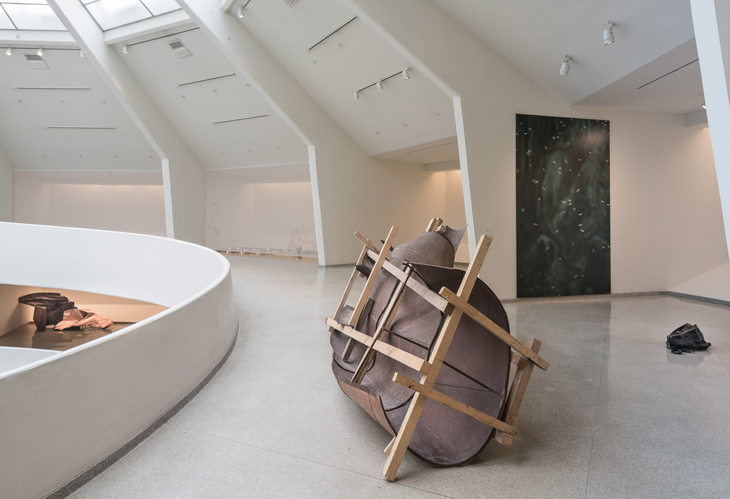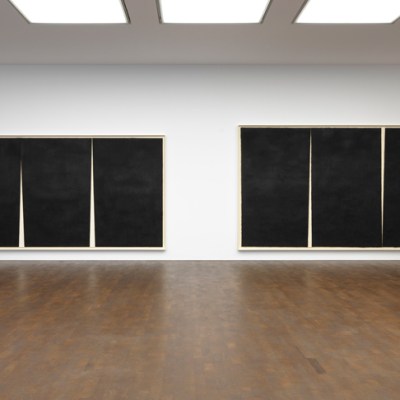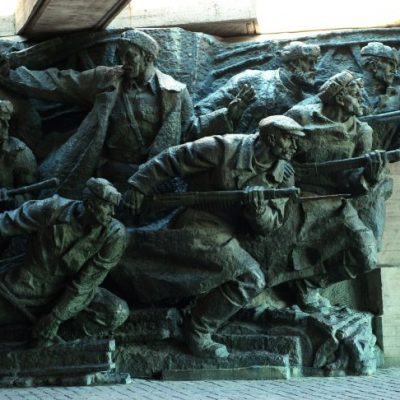Taking over the entire Guggenheim Museum, Danh Vo’s solo exhibition ‘Take My Breath Away’ (yes, like the Berlin song) begins with an architectural intervention: he has had the museum’s famous oculus uncovered. Daylight washes over the familiar rotunda, and viewers pause before they begin their ascent upwards: the skylight has not been visible for years (the unfiltered light damages paintings). To see the Frank Lloyd Wright building in its intended state is an experience that sets the scene for Vo’s exhibition, a successful experiment in pace, hanging, and installation. While allowing for the more than 100 objects to shine in the different settings the building offers, the show also unites the works around themes that are both political and personal. The exhibition is a constant reminder that the objects around us carry meaning within them.
Installation view of ‘Danh Vo: Take My Breath Away’ (2018), Guggenheim Museum, New York. Photo: David Heald; © Solomon R. Guggenheim Foundation, 2018

Vo, who fled Vietnam in 1979 with his family when he was 4 years old and was raised in Denmark, brings together objects of personal or national importance, using the museum as a frame through which to examine them. The methodology is consistent: the artist procures objects at auction, buys them from antiques dealers, collects them in gift shops or corner stores, or takes them from his own family, and presents them, often unmodified, like readymades; the focus, however, is on their provenance rather than their status as art. It’s very conceptual, language heavy-work: in order, for example, to know that Oma Totem (2009) – a column stacking a Philips television, Gorenje washing machine, and Bomann refrigerator – is made up of the objects given to the artist’s grandmother by an immigrant relief programme when she arrived in Germany, you have to read the wall label. Vo replaced the appliances for his maternal grandmother before incorporating them into his work; the new fridge surely works just as well, but the old one, with a crucifix received from her local church attached to it, is an image of larger societal shifts: migration, welcome, the unfamiliar and the new, fear and hope.
Installation view of ‘Danh Vo’ at Museo Jumex (2014–15, Mexico City), showing Oma Totem (2009). Photo: Abigail Enzado and Emilio Bernabé Garcia; courtesy Museo Jumex, Mexico City

How to look at Vo’s work? A simple answer: read. Read the wall labels and trace the stories he recounts about Vietnam, migration, and the movement of objects away from their intended use and into a personal system of references: Ferse (2013) sees gift bags printed with the image of the Statue of Liberty opened out to form a large surface on to which the artist’s father, Phung Vo, wrote a section of the original Cinderella in English in stylised red calligraphy. These are mainly stories about art and display: the emblematic works in this exhibition, for example, are three chandeliers taken from the Hôtel Majestic in Paris, where the Paris Peace Accords, which formally ended the Vietnam War, were signed. One chandelier hangs early in the walk through the rotunda; another is still encased in the travel case built for it at the Centre Pompidou (making the trip from Paris, again); and the last one is disassembled and laid out on the floor. All three are titled with a date and time, for example 08:03, 28.05 (2009): the moment when they were taken off the ceiling at the Majestic, their function as both material witness and dazzling distraction now over.
The story Vo tells about art is also one of reverence, and how an object – like the 16th-century sculpture he bought from an antiques dealer in Amsterdam and carved up to fit into six carry-on suitcases – changes meaning according to its ownership: it is now Untitled (2008), six Danh Vo artworks; the medium: carry-on bag and fruitwood St Joseph.
Installation view of ‘Danh Vo: Take My Breath Away’ (2018), Guggenheim Museum, New York. Photo: David Heald; © Solomon R. Guggenheim Foundation, 2018

If carving up historical objects seems like a violent gesture, that’s because it is, just as there is violence lurking in one of Vo’s hallmark works: a collection of the personal letters of Henry Kissinger, written in the 1970s when he was Secretary of State overseeing US policy in south-east Asia to the New York Post theatre critic Leonard Lyons to thank him for securing theatre tickets. In one, Kissinger confesses he is unable to attend the ballet because of ‘contemplation of Cambodia’; in another, ‘I will let you know if ever I am able to break away.’ Vo makes clear the triviality of Kissinger being ‘tantalised’ by the promise of Broadway tickets while also managing far-flung wars: when things shift from their original context they are exposed, revealing the violence they contain within them. (Take the title of the show: as you hum Berlin’s chart-topper in your mind, the wall text reminds you that it played in the climactic love scene in Top Gun, the 1986 film starring Tom Cruise and Val Kilmer as fighter pilots, which glorified the violence inherent in their jobs.)
Vo’s work teaches us to examine what the stuff of the past tells us about the present. How to look at this art? The easy answer: read. The hard answer? It is read like you would a dictionary, or a thesaurus: read like a web of relations, a system of connections that need to be made. The meaning that objects hold within them is a reflection of the interrelated histories of power that have shaped the world we live in now. The last work on view at the top of the Guggenheim’s spiralling ramp is Untitled (Les grands voyages) (2014–15), which features two plants in Talavera pottery, ceramics made using a glazing technique brought to Spain by the Moors in the 12th century and then carried on to Mexico during the Spanish colonial period. Vo, who lives in Mexico City, commissioned the pots, which are decorated with gory scenes of the voyages to the new world, from craftsmen near his home. The plants, set in pots that contain a history of colonialism, flourish in the sun from the uncovered oculus.
‘Danh Vo: Take My Breath Away’ is at the Guggenheim Museum, New York, until 9 May.
From the April issue of Apollo. Preview and subscribe here.



